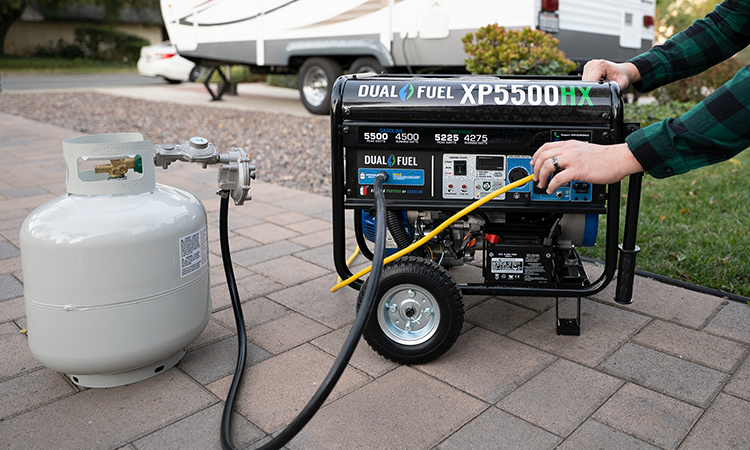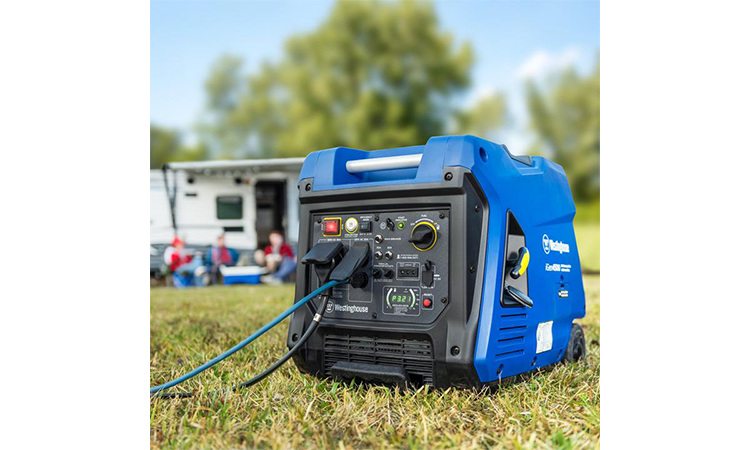A home in the Giddings area with a Generac standby generator and essential pieces of equipment that allow it to switch from electric grid power to generator power. A Bluebonnet line worker must be on site to disconnect power to a member’s home before a standby generator can be installed. (Alyssa Dussetschleger photo)
By Alyssa Dussetschleger
After last February’s record winter storm, Central Texas residents have rushed to buy back-up generators in case their electricity is out for a prolonged period. However, generators can be dangerous, particularly portable ones that typically run on gasoline. A larger, permanently mounted standby generator, installed by a licensed, qualified electrician, can be a safer option, but they are backlogged by months at retailers, are more expensive and also pose some hazards. Although the National Oceanic and Atmospheric Administration predicts a warmer Texas winter in 2022, the Farmers’ Almanac says January could bring subfreezing temperatures. Whatever the winter of 2022 has in store for Central Texas, consumer interest in standby generators is likely to continue well beyond the season.
About standby generators
Although less-expensive portable generators are readily available, more costly and larger standby generators are getting attention from many Central Texas residents because they produce more power and are safer than portables.
These larger home generators must be permanently mounted outdoors by licensed, qualified professionals. Because they are in high demand in Texas, there are lengthy waitlists to buy and install these generators.
Home Depot and Lowe’s offer standby generators for $2,500 to $6,500, based on size requirements. Consultation and installation costs range from $3,000 to $6,500.
Among the most popular manufacturers of standby generators are Generac, Champion, Briggs & Stratton and Honeywell. The most popular brand sold by Zaskoda Repair in the city of Caldwell is Generac’s Guardian 24,000-watt generator. “These are typical for 2,000- to 2,200-square-foot homes,” said Zaskoda Repair’s owner, Tim Zaskoda. At his store, a generator, materials and installation range from $12,000 to $14,000. You can get an assessment appointment within two weeks from Zaskoda, but demand has led to months-long delays of generator delivery and installation.
In the Brenham area of Washington County, Zenith Power Systems sells and installs generators, but they have a waitlist of about six months for generators to arrive and be installed. The waitlist is shorter (about three months) for the company to send a factory-trained technician to survey your property and help you select a generator.
When connecting a standby generator, a certified generator installer or licensed electrician must temporarily have Bluebonnet disconnect your electric power to safely connect the generator to a transfer switch and your meter.
Bluebonnet members can speak to a member service representative by calling 800-842-7708 from 8 a.m. to 5 p.m., Monday through Friday, to schedule a line worker to temporarily disconnect power to the members’ home or business while a generator is installed and reconnect power when the job is done. Line workers also inspect the connection from the generator to the meter to ensure it meets safety requirements.
Standby generators require annual maintenance, and many installers offer annual maintenance packages for a few hundred dollars.
Kenny Lehmann, a Bluebonnet maintenance specialist in Giddings, installed a standby generator at his home in October 2020. He tests it weekly, using an app on his smartphone to turn it on. The app lets him manually operate the generator, see when it is running and how much power it is supplying.
Standby generators can still be dangerous. Overloading the generator by using more power than the machine is rated for can damage it and anything connected to it. However, when properly installed and safety measures followed, standby generators are far less dangerous than their smaller, portable counterparts.
The ABCs of generators
There are three basic types of generators, which vary in size, price, power source and safety:
Standby
Standby (whole house) generators are the most powerful and safest for home use. They range in power from 5,000 to 50,000 watts, and can cost nearly $2,000 up to $20,000. They run on natural gas or liquid propane and must be installed by a licensed, qualified electrician. A typical home requires, at minimum, a 5,000-watt generator to power its electric essentials. Right now, large permanently pad-mounted standby generators are backlogged several months at major home improvement stores, and for as long as a year for some area retailers that sell the popular Generac brand.
Portable

Portable generators typically run on gasoline, but some use diesel or propane. They can provide 3,000 to 8,500 watts of power and cost about $400 up to $2,500. In November 2021, many were available in large home improvement stores in the Bluebonnet region. Lower-cost, lower-power models provide just enough power for essential items, such as a refrigerator and to charge a few phones. Portable generators can produce harmful levels of carbon monoxide if operated in an enclosed area. At least 430 people die from carbon monoxide poisoning every year, according to the Centers for Disease Control and Prevention. This type of death is preventable if portable generators are operated outdoors and safety guidelines are followed.
Inverter

Inverter generators produce about the same amount of power as portable generators and also operate on gasoline. They cost from $300 to $4,000 and must be operated outdoors to prevent carbon monoxide poisoning. They are usually lighter and more quiet than portable generators because they automatically throttle down to provide only power when it is needed, according to Lowe’s home improvement store website. A 2,000-watt inverter generator can power a single household appliance.
Standby generator dos and don'ts
DO plan ahead for how much power you’ll need from the generator. It should produce more power than you think you’ll need in order to avoid an overload. Find a sizing calculator at generac.com.
DO keep your generator on a flat, stable surface, with its exhaust venting away from windows and doorways. This will prevent carbon monoxide poisoning. A generator cover can protect it from the elements.
DO use the proper type of extension cords that are in good condition. Using frayed or ungrounded cords could cause a fire or electric shock. Overloading a multi-plug extension cord can be dangerous.
DO use qualified, licensed electricians to install and maintain your generator, and follow all manufacturer directions and local regulations.
DO install battery-operated carbon monoxide alarms in your home.
DON’T overload a generator. Look at its power rating. Overloading can damage valuable appliances and electronics.
DON’T connect a generator to your home’s wiring without a professionally installed transfer switch. That switch prevents backfeeding (reversal) of electricity along power lines, which could pose safety risks to line workers restoring power during an outage.
DON’T use your generator if it is wet or in standing water, or if you are wet. That could result in safety hazards and damage to the generator. Try to keep the generator dry and covered.
Download this story as it appeared in the Texas Co-op Power magazine »





